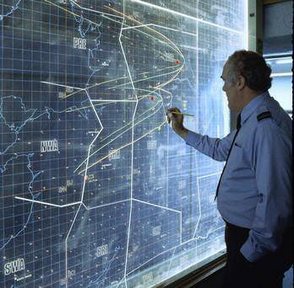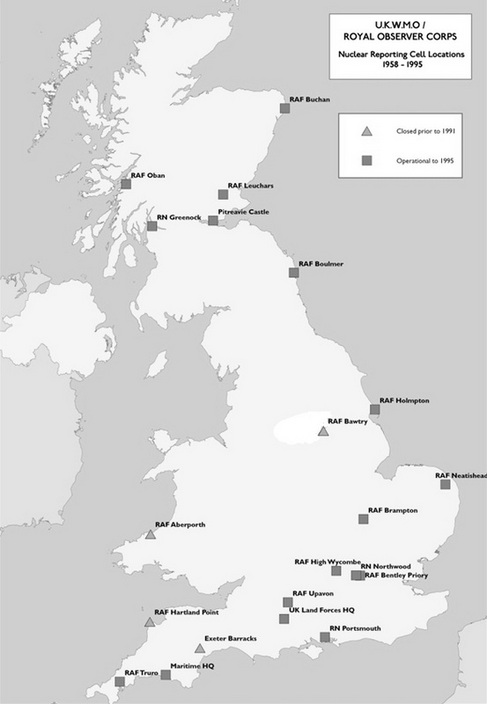1990's: NUCLEAR THAW & ROC STAND-DOWN

Plotting path of nuclear fallout within Nuclear Reporting Cell
The fall of the Berlin Wall
After 38-years in existence, 1989 saw the monumental event leading to the fall of the Berlin Wall and leading from the event the eventual collapse of communism and the final end to the Cold War with the ending of the Union of Soviet Socialist Republics (USSR / CCCP) in December 1991.
Generally seen as a result of the collapse of Communism and the end of the Cold War but also as a result of significant defence spending review that was undertaken the previous year the main body of the Corps within the monitoring posts and group controls were stood down on the 30 September 1991 following the laying up of the original 1966 ROC Royal Banner at St Clement Danes Church in London. A replacement banner that had been presented by Queen Elizabeth II at the Royal Review of the Corps earlier in July 1991 was also placed into safe keeping in the Rotunda at RAF Cranwell in Lincolnshire.
The ROC, along with the UKWMO, was officially de-established following what was described by The Queen at the 1991 Royal Review as "the end of the Cold War". This move was linked to a Government press release which referred to "possible future developments and improvements in automated nuclear explosion and fallout detection from remote sensors". Although the role of the Corps had changed completely between WW2 and the Cold War, the traditional links with the Royal Air Force remained and the skill of visual aircraft recognition was still maintained by post observers up until stand-down in 1991.
After 38-years in existence, 1989 saw the monumental event leading to the fall of the Berlin Wall and leading from the event the eventual collapse of communism and the final end to the Cold War with the ending of the Union of Soviet Socialist Republics (USSR / CCCP) in December 1991.
Generally seen as a result of the collapse of Communism and the end of the Cold War but also as a result of significant defence spending review that was undertaken the previous year the main body of the Corps within the monitoring posts and group controls were stood down on the 30 September 1991 following the laying up of the original 1966 ROC Royal Banner at St Clement Danes Church in London. A replacement banner that had been presented by Queen Elizabeth II at the Royal Review of the Corps earlier in July 1991 was also placed into safe keeping in the Rotunda at RAF Cranwell in Lincolnshire.
The ROC, along with the UKWMO, was officially de-established following what was described by The Queen at the 1991 Royal Review as "the end of the Cold War". This move was linked to a Government press release which referred to "possible future developments and improvements in automated nuclear explosion and fallout detection from remote sensors". Although the role of the Corps had changed completely between WW2 and the Cold War, the traditional links with the Royal Air Force remained and the skill of visual aircraft recognition was still maintained by post observers up until stand-down in 1991.
|
Letter issued by 15 Group Lincoln as a result of the stand-down of the ROC announced at the Royal Review in 1991.
| ||||||
The NRCs post 1991: “Beyond the Cold”
While the main body of the Royal Observer Corps was stood down from operational service a decision was taken by the Ministry of Defence (MOD) to retain the Nuclear Reporting Cell (NRC) element of the Corps, in order to continue providing a Nuclear, Biological and Chemical (NBC) service for all three armed forces.
From October 1991 17 (later reduced to 16) NRCs were retained and staffed by 240 other ranks and 16 spare-time officers with control of the NRC groups being transferred from the UKWMO to the administration of Headquarters ROC (HQROC) based at RAF Bentley Priory. At the same time the name of the NRC’s changed to Nuclear, Biological and Chemical Cell (NBCC) to reflect their main role of the provision of Nuclear, Biological and Chemical Assessments for the military forces.
The control of the Corps had therefore gone full circle; the Corps was once again fully funded and controlled by the Royal Air Force and became part of Headquarters No 11 Group at RAF Bentley Priory. HQROC, which comprised two whole-time officers and two MOD civilian staff, continued to administrate the remaining NBC cells which were now based at various RAF / military installations throughout the UK.
Operations within the Cells were based on the NATO NBC procedures (ATP45) which generally consisted of;
While the main body of the Royal Observer Corps was stood down from operational service a decision was taken by the Ministry of Defence (MOD) to retain the Nuclear Reporting Cell (NRC) element of the Corps, in order to continue providing a Nuclear, Biological and Chemical (NBC) service for all three armed forces.
From October 1991 17 (later reduced to 16) NRCs were retained and staffed by 240 other ranks and 16 spare-time officers with control of the NRC groups being transferred from the UKWMO to the administration of Headquarters ROC (HQROC) based at RAF Bentley Priory. At the same time the name of the NRC’s changed to Nuclear, Biological and Chemical Cell (NBCC) to reflect their main role of the provision of Nuclear, Biological and Chemical Assessments for the military forces.
The control of the Corps had therefore gone full circle; the Corps was once again fully funded and controlled by the Royal Air Force and became part of Headquarters No 11 Group at RAF Bentley Priory. HQROC, which comprised two whole-time officers and two MOD civilian staff, continued to administrate the remaining NBC cells which were now based at various RAF / military installations throughout the UK.
Operations within the Cells were based on the NATO NBC procedures (ATP45) which generally consisted of;
- Prediction of chemical hazard areas and meteorological considerations.
- The estimation of the yield of a nuclear device.
- The prediction of nuclear fallout onshore and at sea.
- General Information relating to the nature and importance of nuclear fallout.
From 1991 the ever diminishing threat to the UK continued with the ROC staff providing a high level of service to their clients within the Cells. At the same time however many believed there to exist power struggles within the RAF / RAF Regiment and especially in the senior elements of the RAF Regiment who felt that it was not right that spare time civilians undertook the NBC role, when cuts to full-time servicemen was a possibility. Ultimately the decision was finally taken to stand-down the remaining element of the Royal Observer Corps on the 31st December 1995.
Image Source: ROC Journal
Map Source: South Yorkshire ROC Collection
Map Source: South Yorkshire ROC Collection
